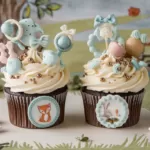Welcome to the wonderful, but sometimes overwhelming world of parenthood! As a lactation specialist, I understand how challenging it can be to keep your baby’s feeding equipment clean. Cleaning baby bottles can seem daunting for new parents, but finding simple ways to do so can ease the stress. Let’s explore essential tips and best practices to maintain sanitized, spotless baby bottles.

In this blog post, we will cover:
- The importance of keeping baby bottles clean and sanitized.
- Essential tools you need for effective cleaning.
- Step-by-step instructions for cleaning and sanitizing baby bottles.
- Common mistakes to avoid and tips for proper storage.
Why Keeping Baby Bottles Clean is Important

- Health Risks: According to the CDC, sterilizing baby bottles is crucial, especially for premature babies or those with weakened immune systems.
- Personal Experience: One mother I worked with found that improper cleaning led to colic in her baby; after adjusting her routine, her baby’s health improved dramatically.
- Cleaning Balance: Regular sterilization can damage bottles, particularly BPA-containing ones. Cleanliness is essential, but so is maintaining the integrity of the bottles.
- Awareness: Milk residues can harbor bacteria, particularly in crevices and nipples. Meticulous cleaning prevents illness and keeps your baby healthy.
Essential Tools for Cleaning Baby Bottles

You’ll need a few key items to simplify cleaning:
- High-Quality Bottle Brush: Designed for baby bottles to reach hard-to-clean areas.
- Mild Dish Soap: Choose a baby-safe detergent that’s effective without leaving harmful residues.
- Drying Rack: Helps prevent mildew and mold by maximizing air circulation.
- Dishwasher (Optional): A dishwasher with a sanitize mode can automate the cleaning process.
- Sterilizer (Optional): Especially useful for newborns or preemies for extra protection against germs.
How to Clean Baby Bottles: A Step-by-Step Guide

- Disassemble: Separate bottles into individual parts: nipples, rings, caps, and inserts.
- Rinse: Rinse each part under warm water to remove milk residue.
- Scrub: Use a bottle brush with mild dish soap, paying special attention to:
- Nipples
- Threading
- Crevices
- Rinse Again: Rinse under running water to remove soap residue.
- Dry: Place on a drying rack to air dry completely.
How to Sanitize Baby Bottles Using Boiling Water

- Preparation: Fill a large pot with water and bring it to a rolling simmer.
- Submerge: Use tongs to lower the bottle parts into the water.
- Simmer: Let them simmer for 5 minutes to eliminate bacteria.
- Cool Down: Remove using tongs and let air dry on a clean surface.
Dishwasher Cleaning Baby Bottles

- Disassemble Bottles: Separate parts before loading.
- Load Top Rack: Place bottles on the top shelf to prevent warping.
- Sanitize Setting: Use the sanitize cycle with baby-safe soap.
- Air Dry: Allow bottles to dry completely after the cycle.
Electric Sterilizers: Pros and Cons

- Pros:
- Easy to use with one-button operation.
- Chemical-free sanitization.
- Cons:
- Can be costly and take up counter space.
- Requires regular maintenance to prevent scale buildup.
Microwaves for Sterilizing Baby Bottles

- Ensure Microwave-Safe: Use microwave-safe bags or containers.
- Add Water: Include a small amount of water as directed by the manufacturer.
- Seal and Microwave: Seal properly and microwave for 1 to 5 minutes.
- Cool Down: Let the bag cool before opening to avoid burns.
How to Clean Silicone Baby Bottles

- Durability: Silicone bottles withstand boiling water and sterilization without losing shape.
- Easy Cleaning: Their non-porous material makes removing residues straightforward.
- Safety: No risk of harmful chemicals leaching into milk.
How to Store Clean Baby Bottles

- Ensure Dryness: Make sure all parts are completely dry to prevent mold.
- Store Properly: Use closed cabinets or containers to keep out dust.
- Organize: Utilize a bottle organizer to prevent mismatched parts.
- Avoid Airtight Containers: Choose breathable options to allow air circulation.
Common Mistakes to Avoid When Cleaning Baby Bottles

- Over-Sterilizing: Can damage bottles and leach chemicals.
- Ignoring Wear: Check for cracks, smells, or warping regularly.
- Skipping Rinses: Residual soap can upset your baby’s stomach.
- Rushing Drying: Ensure bottles dry completely before storage.
Commercial Products vs. DIY Cleaning Solutions

- DIY Solutions: Vinegar and baking soda can effectively cut through residues.
- Commercial Products: Designed to be hypoallergenic and safe for babies.
- Personal Preference: Choose what works best for you while ensuring safety.
How to Replace Your Baby Bottles

- Regular Inspections: Replace bottles showing signs of damage.
- Check Nipples: Replace as they wear out faster than bottles.
- Recommended Frequency: Consider replacing bottles every 3 to 6 months for safety.
Conclusion
Regular cleaning and proper maintenance of your baby’s bottles will help ensure safe feedings and give you peace of mind. By following these guidelines, you can navigate your busy parenting schedule with confidence, knowing your baby’s health is a priority.









